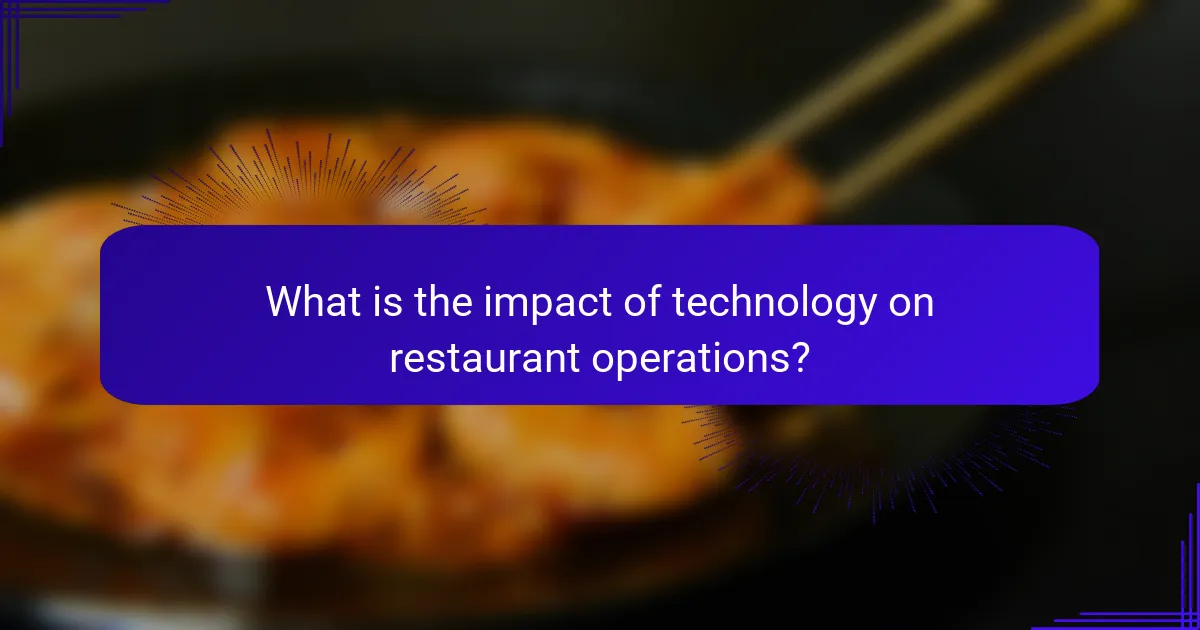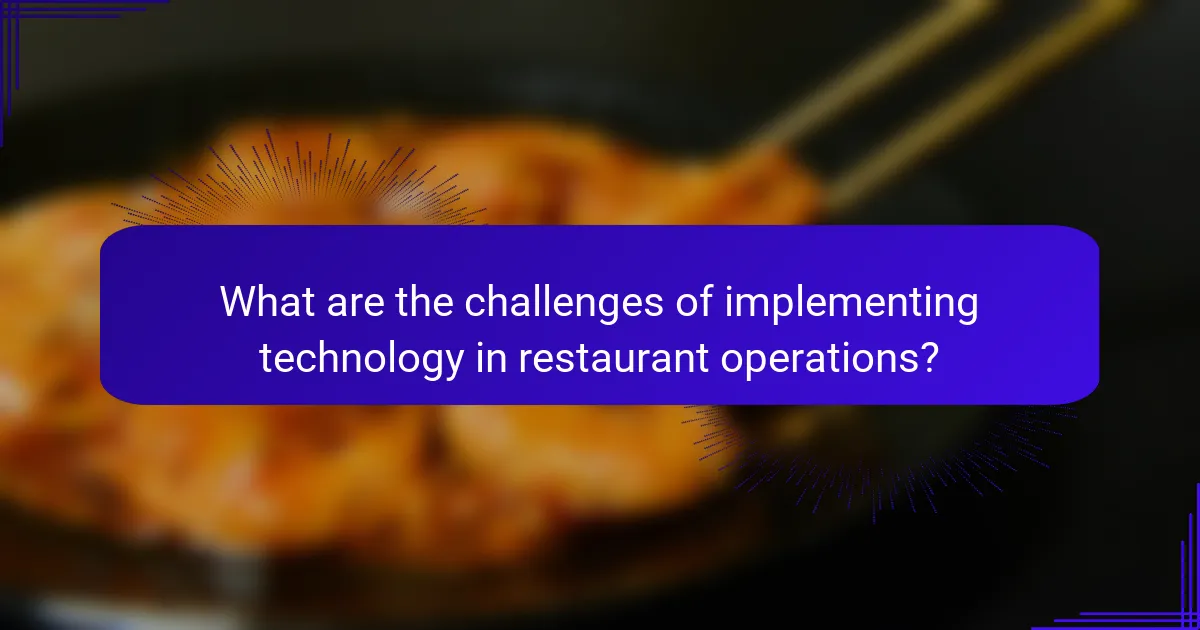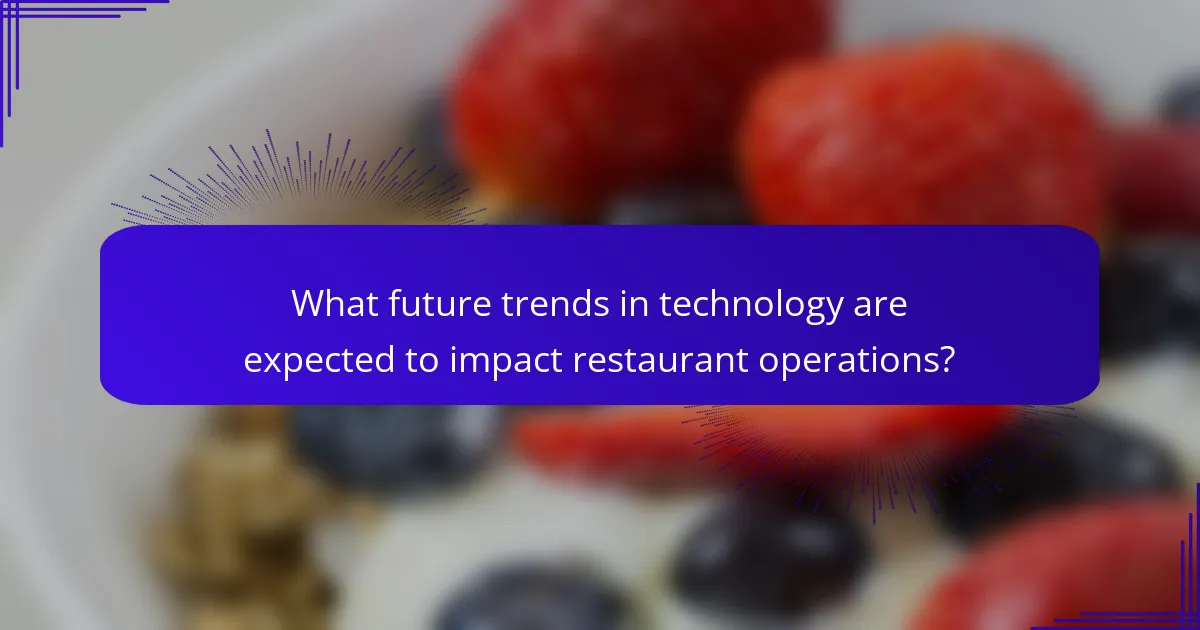
What is the impact of technology on restaurant operations?
Technology significantly enhances restaurant operations. It streamlines processes, improves efficiency, and elevates customer experience. For instance, point-of-sale systems automate order processing and reduce errors. Online reservations and ordering systems increase accessibility for customers. Inventory management software optimizes stock levels and minimizes waste. Employee scheduling tools improve labor management and reduce costs. Data analytics provides insights into customer preferences and operational performance. According to a 2021 study by the National Restaurant Association, 70% of restaurant operators reported technology investments improved their overall efficiency.
How has technology historically influenced restaurant operations?
Technology has historically influenced restaurant operations by streamlining processes and enhancing customer experiences. The introduction of mechanical kitchen equipment in the late 19th century improved food preparation efficiency. Refrigeration technology, developed in the early 20th century, allowed for better food preservation and inventory management. The advent of point-of-sale systems in the 1980s automated order processing and improved transaction accuracy. Online reservation systems emerged in the 1990s, increasing customer convenience and optimizing table management. The rise of mobile apps in the 2000s further transformed customer engagement and ordering processes. Each technological advancement has contributed to operational efficiency and better service delivery, shaping the modern dining experience.
What key technological advancements have shaped the restaurant industry?
Key technological advancements that have shaped the restaurant industry include point-of-sale (POS) systems, online ordering platforms, and kitchen display systems. POS systems streamline transactions and inventory management. They enhance operational efficiency and accuracy. Online ordering platforms cater to consumer demand for convenience. They enable restaurants to reach a wider audience. Kitchen display systems improve communication between front-of-house and back-of-house staff. They reduce errors and speed up food preparation. Additionally, mobile payment solutions have increased transaction speed and customer satisfaction. These advancements collectively transform restaurant operations and enhance the overall customer experience.
How did early technologies change food service practices?
Early technologies significantly transformed food service practices by introducing efficiency and consistency. The invention of the steam engine in the 18th century allowed for faster cooking methods. This reduced food preparation time and improved service speed. Refrigeration technology emerged in the 19th century, enabling longer food preservation. This innovation decreased food spoilage and expanded menu options.
Additionally, the introduction of gas and electric stoves improved cooking precision. This advancement enhanced food quality and safety. The development of dishwashing machines streamlined cleaning processes in kitchens. This saved labor and improved hygiene standards.
Overall, early technologies revolutionized food service by enhancing operational efficiency, food safety, and customer satisfaction.
What efficiency gains can be attributed to technological advancements in restaurants?
Technological advancements in restaurants lead to significant efficiency gains. Automation in food preparation reduces labor costs and speeds up service. Point-of-sale systems streamline order processing and payment. Inventory management software minimizes waste and optimizes stock levels. Online ordering platforms expand customer reach and improve order accuracy. Kitchen display systems enhance communication between front and back of house. Data analytics helps in understanding customer preferences and improving menu offerings. According to a report by the National Restaurant Association, 70% of operators believe technology improves efficiency.
How do modern point-of-sale systems improve transaction efficiency?
Modern point-of-sale (POS) systems improve transaction efficiency by streamlining payment processes. They enable quick scanning of items, reducing checkout time. These systems often integrate with inventory management, ensuring real-time stock updates. They also support multiple payment methods, including contactless options. Enhanced data analytics provide insights into sales trends, allowing for better decision-making. According to a study by the National Restaurant Association, restaurants using advanced POS systems report a 20% increase in transaction speed. This efficiency leads to improved customer satisfaction and higher turnover rates.
What role does kitchen automation play in enhancing productivity?
Kitchen automation significantly enhances productivity by streamlining food preparation and cooking processes. Automated systems reduce manual labor, allowing staff to focus on other essential tasks. Equipment like robotic arms and automated fryers can operate continuously without fatigue. This leads to faster meal preparation times and increased output. Studies show that restaurants implementing automation can boost efficiency by up to 30%. Additionally, automation minimizes human error, ensuring consistent food quality. Overall, kitchen automation plays a crucial role in optimizing restaurant operations and improving service speed.
How does technology improve the overall customer experience in restaurants?
Technology enhances the overall customer experience in restaurants by streamlining operations and personalizing service. Digital menus allow customers to view options quickly and easily. Online ordering systems enable convenient pre-ordering and payment. Mobile apps facilitate loyalty programs, providing tailored rewards to frequent diners. Reservation systems reduce wait times, improving customer satisfaction. Tabletop tablets can enhance dining interaction with games and additional menu information. Data analytics helps restaurants understand customer preferences, enabling more personalized experiences. These advancements lead to increased efficiency and customer loyalty, ultimately improving overall satisfaction.
What are the benefits of online reservations and ordering systems?
Online reservations and ordering systems streamline restaurant operations. They reduce wait times for customers and enhance convenience. Customers can place orders anytime, increasing sales potential. These systems provide real-time inventory management. They also minimize human error in taking orders. Data from these systems can improve customer insights. They enable targeted marketing strategies based on customer preferences. Research indicates that restaurants using these systems see a 20% increase in efficiency.
How does technology facilitate personalized customer interactions?
Technology facilitates personalized customer interactions by enabling tailored communication and services. It collects data on customer preferences and behaviors through various channels. This data allows businesses to customize marketing messages and offers. For instance, restaurants can use loyalty programs to track customer visits and preferences. They can then send personalized promotions based on individual dining habits. Additionally, technology like AI chatbots provides instant responses to customer inquiries. This enhances the customer experience by offering timely and relevant information. A study by McKinsey shows that 71% of consumers expect companies to deliver personalized interactions. This highlights the importance of technology in meeting customer expectations effectively.

What are the challenges of implementing technology in restaurant operations?
Implementing technology in restaurant operations presents several challenges. These include high initial costs for hardware and software. Staff training is often required to effectively use new systems. Integration with existing processes can be complex and time-consuming. Resistance to change among employees can hinder adoption. Ongoing maintenance and updates can strain resources. Cybersecurity threats pose risks to sensitive customer data. Lastly, ensuring reliable internet connectivity is crucial for seamless operations.
What barriers do restaurants face when adopting new technologies?
Restaurants face several barriers when adopting new technologies. High initial costs can deter investment. Many restaurants operate on thin profit margins. Limited technical expertise among staff can complicate implementation. Resistance to change is common in established operations. Integration with existing systems poses additional challenges. Data security concerns can hinder adoption. Lastly, lack of customer demand for specific technologies may limit motivation to invest. These barriers collectively impact the pace of technological advancement in the restaurant industry.
How can cost implications hinder technological advancements?
Cost implications can significantly hinder technological advancements in restaurant operations. High costs can limit investment in new technologies. Restaurants may avoid adopting advanced systems due to budget constraints. This reluctance can result in outdated processes and inefficiencies. For instance, a survey by the National Restaurant Association found that 62% of operators cited cost as a barrier to adopting new technology. Limited budgets can also restrict training for staff on new systems. Without proper training, the potential benefits of technology may not be fully realized. Consequently, restaurants may fall behind competitors who embrace innovation. Overall, financial limitations can stifle progress in enhancing operational efficiency and customer experience.
What issues arise from staff training on new systems?
Staff training on new systems can lead to various issues. One significant issue is resistance to change among employees. Employees may feel comfortable with existing processes and may be reluctant to adopt new systems. This resistance can hinder the overall effectiveness of the training program.
Another issue is the potential for inadequate training resources. If training materials are unclear or insufficient, employees may struggle to understand the new system. This can result in errors during operations, affecting service quality.
Additionally, time constraints can pose a challenge. Staff may have limited time to engage in training while managing their regular duties. This can lead to incomplete training and gaps in knowledge.
Moreover, varying levels of technological proficiency among staff can create disparities in learning. Some employees may grasp the new system quickly, while others may require more support. This inconsistency can affect team dynamics and operational efficiency.
Finally, ongoing support post-training is crucial. Without adequate follow-up, employees may revert to old habits or fail to utilize the new system effectively. Continuous support helps reinforce the training and ensures long-term adoption.
How does data security impact technology use in restaurants?
Data security significantly impacts technology use in restaurants by influencing operational efficiency and customer trust. Restaurants that prioritize data security can implement advanced technologies like POS systems and online ordering platforms. These technologies streamline operations and enhance customer experience. However, if data security is compromised, it can lead to data breaches. According to a 2020 report by Verizon, 28% of data breaches in the hospitality industry involved payment card information. Such breaches can result in financial losses and damage to reputation. Consequently, restaurants may hesitate to adopt new technologies without robust security measures. This creates a barrier to innovation and efficiency gains in the industry.
What are the risks associated with customer data management?
The risks associated with customer data management include data breaches, compliance issues, and data loss. Data breaches can expose sensitive customer information, leading to financial loss and reputational damage. According to a report by IBM, the average cost of a data breach in 2021 was $4.24 million. Compliance issues arise from failing to adhere to regulations like GDPR or CCPA, resulting in fines and legal consequences. Additionally, data loss can occur due to system failures or human errors, disrupting business operations. These risks highlight the critical need for robust data security measures and compliance protocols.
How can restaurants protect themselves from cyber threats?
Restaurants can protect themselves from cyber threats by implementing robust cybersecurity measures. They should regularly update software and systems to patch vulnerabilities. Using firewalls and antivirus programs can help block malicious attacks. Employee training on recognizing phishing attempts is essential for prevention. Restaurants should also secure their Wi-Fi networks to prevent unauthorized access. Regularly backing up data ensures recovery in case of an attack. Monitoring systems for unusual activity can provide early detection of threats. According to a report by the National Restaurant Association, 75% of restaurants experienced a cyber incident in the past year, highlighting the need for these protections.

What future trends in technology are expected to impact restaurant operations?
Future trends in technology expected to impact restaurant operations include automation, AI, and contactless services. Automation will streamline kitchen processes, improving efficiency and reducing labor costs. AI will enhance customer experience through personalized recommendations and inventory management. Contactless services will increase safety and convenience, especially in a post-pandemic world. These trends are supported by a growing demand for efficiency and safety in dining experiences. According to a report by the National Restaurant Association, 75% of restaurant operators plan to invest in technology to improve operations.
How will artificial intelligence shape restaurant management?
Artificial intelligence will significantly shape restaurant management by enhancing operational efficiency and improving customer experiences. AI can streamline inventory management by predicting stock needs based on historical data. This reduces waste and ensures that popular items are always available. Additionally, AI-driven analytics can optimize staffing levels according to customer traffic patterns.
AI-powered chatbots can handle reservations and customer inquiries, freeing staff for other duties. Furthermore, personalized marketing campaigns can be developed using AI to analyze customer preferences and behaviors. This leads to better-targeted promotions and increased customer loyalty.
According to a report by the National Restaurant Association, 70% of restaurant operators believe that technology will improve their operations. This underscores the transformative potential of AI in the restaurant industry.
What potential does AI have in enhancing customer service?
AI has significant potential in enhancing customer service. It can automate responses to common inquiries. This reduces wait times for customers. AI-driven chatbots can provide 24/7 support. They handle multiple customer interactions simultaneously. According to a study by McKinsey, AI can improve customer satisfaction by 20%. AI can also analyze customer data to personalize experiences. This leads to tailored recommendations and promotions. Additionally, AI can predict customer needs based on past behavior. This proactive approach enhances overall service quality.
How can AI optimize inventory management in restaurants?
AI can optimize inventory management in restaurants by predicting demand accurately. It uses historical sales data to forecast future inventory needs. This helps reduce food waste significantly. According to a study by the National Restaurant Association, food waste costs the industry approximately $162 billion annually. AI algorithms can analyze trends, seasonality, and customer preferences. This allows restaurants to maintain optimal stock levels. Moreover, AI can automate reordering processes. This ensures that popular items are always available while minimizing excess inventory.
What role will sustainability play in future restaurant technologies?
Sustainability will be a critical component of future restaurant technologies. Restaurants will increasingly adopt eco-friendly practices to reduce their carbon footprint. Innovations such as energy-efficient appliances will minimize energy consumption. Smart inventory management systems will reduce food waste by optimizing stock levels. Water-saving technologies will help conserve resources in food preparation and cleaning. According to the National Restaurant Association, 60% of consumers prefer restaurants that practice sustainability. This consumer preference will drive restaurants to integrate sustainable technologies. Overall, sustainability will shape operational strategies and enhance customer loyalty in the restaurant industry.
How can technology support eco-friendly practices in food service?
Technology can support eco-friendly practices in food service by optimizing resource use and reducing waste. Smart inventory management systems minimize food spoilage by tracking expiration dates and stock levels. Energy-efficient kitchen appliances lower energy consumption, contributing to reduced carbon footprints. Digital ordering systems decrease paper waste by eliminating physical menus and receipts. Composting technologies facilitate the recycling of organic waste, turning it into usable compost. Water-saving devices in kitchens help conserve water usage significantly. Renewable energy sources, like solar panels, can power food service operations sustainably. Data analytics can identify areas for improvement, allowing restaurants to implement more sustainable practices effectively.
What innovations are emerging to reduce waste in restaurants?
Innovations emerging to reduce waste in restaurants include advanced inventory management systems. These systems utilize AI to predict demand accurately. They help minimize over-ordering and spoilage. Another innovation is the use of composting technology. This technology converts food waste into compost, reducing landfill contributions. Additionally, apps are being developed for food donation. These apps connect restaurants with local charities to redistribute surplus food. Smart kitchen appliances are also gaining traction. They monitor food freshness and alert staff when items are nearing expiration. Lastly, some restaurants are adopting zero-waste cooking techniques. These techniques utilize every part of an ingredient, minimizing waste. These innovations collectively contribute to more sustainable restaurant operations.
What best practices should restaurants follow when integrating new technologies?
Restaurants should focus on thorough training for staff when integrating new technologies. This ensures that employees are comfortable and proficient with new systems. Regular updates and maintenance of technology are crucial for optimal performance. Implementing customer feedback mechanisms helps to refine tech usage. Data security measures must be prioritized to protect sensitive information. Establishing clear communication channels enhances coordination during the transition. Pilot programs can be beneficial to test technology before full-scale implementation. Finally, aligning technology with business goals is essential for maximizing efficiency and customer satisfaction.
The main entity of this article is technology as it pertains to restaurant operations. The article examines the impact of technology on efficiency, customer experience, and historical advancements within the restaurant industry. Key topics include the evolution of technological tools such as point-of-sale systems, online ordering platforms, and kitchen automation, which enhance operational efficiency and streamline processes. Additionally, it addresses the challenges of implementing technology, the importance of data security, and future trends like AI and sustainability that are expected to shape restaurant management. Overall, the article highlights how technology transforms restaurant operations and improves service delivery.
